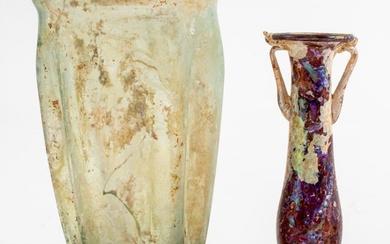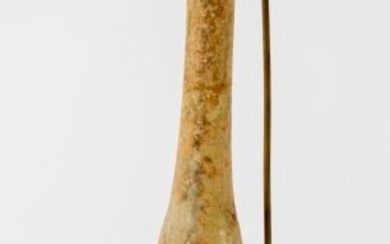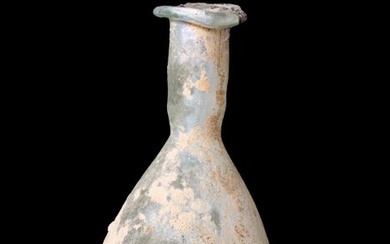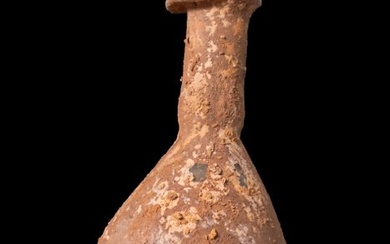Ancient Roman Glass Unguentarium - 5×4.5×5 cm
1st- 4th century A. D. Glass articles were highly in favour with the Romans who acquired them through trade with Egyptians and Phoenicians. But already from the beginning of the Roman Empire they produced their own glassware in the metropolis and outside it, using glass vessels in the same manner as did the Egyptians and Phoenicians while refining their forms to produce objects of great variety and elegance. Just about all Roman burials contain clear or greenish glass vessels covered with an iridescent patina due to the action of humidity and air. These flasks, when made in narrow forms, are often called unguentaria or lacrimaria by collectors, but were only used to contain oils and perfumes in the tombs, not to be containers for tears. Provenance: French auction house Invoice seen by Catawiki. The seller guarantees that he acquired this piece according to all national and international laws related to the ownership of cultural property. Provenance statement seen by Catawiki. The seller will take care that any necessary permits, like an export license will be arranged, he will inform the buyer about the status of it if this takes more than a few days. The Romans also perfected the art of working figures in relief on the glass vessels with the addition of another layer of glass of a different colour, or one of enamel, along with molding, cutting and engraving of the glass, with the result that the surfaces of the containers looked like worked cameos. BIBLIOGRAPHY - ARVEILLER-DULONG, Véronique. NENNA, Marie-Dominique. Les verres antiques au museé du Louvre. Volume II. Museé du Louvre. 2006. - FLEMING, Stuart J. Roman Glass: Reflections on Cultural Change. University of Pennsylvania Museum of Archaeology and Anthropology. 1999.
[ translate ]View it on
Estimate
Time, Location
Auction House
1st- 4th century A. D. Glass articles were highly in favour with the Romans who acquired them through trade with Egyptians and Phoenicians. But already from the beginning of the Roman Empire they produced their own glassware in the metropolis and outside it, using glass vessels in the same manner as did the Egyptians and Phoenicians while refining their forms to produce objects of great variety and elegance. Just about all Roman burials contain clear or greenish glass vessels covered with an iridescent patina due to the action of humidity and air. These flasks, when made in narrow forms, are often called unguentaria or lacrimaria by collectors, but were only used to contain oils and perfumes in the tombs, not to be containers for tears. Provenance: French auction house Invoice seen by Catawiki. The seller guarantees that he acquired this piece according to all national and international laws related to the ownership of cultural property. Provenance statement seen by Catawiki. The seller will take care that any necessary permits, like an export license will be arranged, he will inform the buyer about the status of it if this takes more than a few days. The Romans also perfected the art of working figures in relief on the glass vessels with the addition of another layer of glass of a different colour, or one of enamel, along with molding, cutting and engraving of the glass, with the result that the surfaces of the containers looked like worked cameos. BIBLIOGRAPHY - ARVEILLER-DULONG, Véronique. NENNA, Marie-Dominique. Les verres antiques au museé du Louvre. Volume II. Museé du Louvre. 2006. - FLEMING, Stuart J. Roman Glass: Reflections on Cultural Change. University of Pennsylvania Museum of Archaeology and Anthropology. 1999.
[ translate ]






